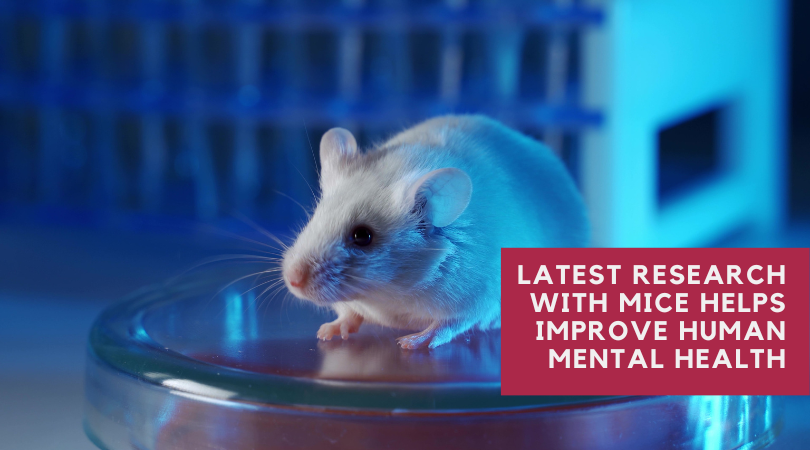Latest Research with Mice Helps Improve Human Mental Health
Posted on
May is Mental Health Month, and researchers around the world are contributing to the effort to identify causes and develop treatments for mental health issues including anorexia, depression, anxiety, addiction, and PTSD.
A New Connection Between Anorexia and the Gut
Anorexia nervosa is one of the most difficult to treat mental illnesses, and one of the most deadly. An estimated 30 million Americans will suffer from an eating disorder during their lifetimes, and 10,200 deaths every year are attributed to eating disorders. Among mental illness-related deaths, eating disorders are second only to opioid abuse, and among eating disorders, anorexia is the most likely to result in death.

Not only is anorexia dangerous, it’s complicated. Until now, it has been understood as largely due to altered brain function, but a new study points to a different source: the gut. A team of scientists from the University of Copenhagen conducted a study with 147 girls and young women, 77 of whom suffered from anorexia nervosa.
Feces from the anorexia group and the control group were transplanted into germ-free mice. The mice who had received the fecal transplant from the anorexia group had trouble gaining weight and showed changes in the brain related to appetite as well as disruptions in the gut microbiome.
The study showed that a disrupted microbiome can be a contributing factor in the development or continuation of anorexia. Further research needs to be done on whether normalizing the intestinal microbiome is effective as a treatment for anorexia when used alongside other treatments such as therapy and changing the patient’s eating habits.
Scientists Identify an “Anxiety Gene”
Anxiety disorders are the most common form of mental illness, affecting about 30% of U.S. adults. Anxiety can have many contributing factors and underlying causes, including environmental, developmental, and genetic.
Now, a team of researchers at the University of Bristol in England have identified a gene that causes anxiety in mice. To induce anxiety in the mice, researchers restrained them for six hours. They then studied their brains and discovered that the mice had elevated levels of miR483-5p, a type of molecule, in the amygdala region, which controls emotions.
Increasing the levels of miR483-5p was shown to suppress the expression of the Pgap2 gene, which was causing anxiety-related behavior in the mice. Identifying a specific pathway for anxiety could help in developing new medications that target and suppress the Pgap2 gene.
French Fries Taste Good but Make Us Feel Bad
It turns out that comfort food may not be all that comforting, at least in the long term. A new study by researchers at Zhejiang University found that people who eat fast food on a regular basis are 58% more likely to show signs of anxiety and depression.
The culprit may be fried food, specifically French fries. In the study, mice fed a diet high in fat and sugar, designed to mimic a fried food-heavy diet in humans, experienced higher levels of anxiety than mice fed a regular diet.
The study pointed to acrylamide, a substance that forms during high-temperature cooking of foods such as potatoes and cereals, as the potential connection. Researchers found that long-term exposure to acrylamide causes anxiety and depressive behaviors.
The study is just the latest proof that eating well makes us feel better.
Psilocybin as Potential treatment for PTSD
Post-traumatic stress disorder (PTSD) occurs when the brain has an extreme fear response to harmless stimuli that trigger memories of an earlier traumatizing event. In essence, PTSD disables the “fear extinction” process in the brain.
A team of Chinese researchers are investigation whether psilocybin, the active chemical in hallucinogenic or “magic” mushrooms, could work to restore fear extinction and thereby treat PTSD.
Psilocybin, which is already being used to treat depression, is known to increase connections between neurons, and the team hypothesized that it might also improve neuroplasticity in the hippocampus.
To test the theory, the researchers induced sound-based fear conditioning in mice by playing a sound followed by a shock. After two days of conditioning, the mice were given a dose of psilocybin accompanied by training to reduce their fear reactions.
The psilocybin-treated mice showed a marked improvement in fear extinction response compared to the mice that did not receive psilocybin, which raised hopes that it could work as a PTSD treatment in humans.
A New Treatment for Opioid Addiction
Opioid addiction resulted in 80,411 overdose deaths in the United States in 2021, and while some statistics show the death rate from opioid overdose may be starting to decline, it’s still at epidemic levels.
A new study from Yale University turns to an old candidate for opioid addiction treatment: the hallucinogenic drug ibogaine, which is derived from the African iboga plant. Put forward as a potential treatment for opioid addiction as far back as the 1960s, ibogaine seemed to eliminate cravings for opioids, but came with serious risks including cardiac arrhythmia, seizures, and death. Its use is banned in the U.S.
Researchers at Yale identified two compounds that function similarly to ibogaine, reducing depression, anxiety, and symptoms related to opioid withdrawal, but can be better controlled to limit side effects. The finding could lead to new treatments for opioid addiction.
In testing the two compounds in mouse models, they were shown to be as or more effective than Prosac for anxiety and depression and more effective than Paxil for opioid withdrawal. The team hopes the compounds could be further explored as treatments on their own or as the basis for further drug development.